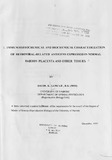| dc.description.abstract | The genomes of all eukaryotes contain multiple copies of DNA sequences that are
related to sequences found in infectious retroviruses . Endogenous retroviruses (ERV s) are
generally non-pathogenic except in mice where they have been found to induce tumours and
immunological disorders. The ERV s have morphological features consistent with type-C
retroviral particles and are expressed in normal placental tissues in most mammals. They have
antigenic similarity with exogenous retroviruses such as HIV -1 and may have a role in the
regulation of cellular gene expression, syncytiotrophoblast formation or pregnancy-related
immunosuppression.
Baboon endogenous virus (BaEV) is the only endogenous retrovirus so far which has
been shown to be infective in vitro. The entire nucleotide sequence of BaEV has been
determined. It has been shown to have a chimeric genomic structure of about 8 kb long.
BaEV particle expression in placental tissues has been demonstrated using electron
microscopy. However, to date, very little work has been done to evaluate the expression of
retroviral-related antigens in normal baboon tissues. In this project, a panel of antibodies
(polyclonal and monoclonal antibodies) against viral proteins (anti-HIV and anti-SfV) were
assessed for their cross-reactivity (using immunohistochemistry) with normal placental and
other baboon tissues. Retroviral particles were further characterized by immunoblotting and
ELISA. Mouse polyclonal antibodies were produced against isolated baboon placental ERV
particles and were also characterized as described above.
Some of the antibodies (anti-HIV-1 gp41, anti-HIV-2 gp120, anti-HIV-1 RT, and
anti-BERV) displayed specific immunoperoxidase staining on placental
syncytiotrophoblast and cross-reacted with exogenous retroviral proteins on immunoblot
analyses. Four monoclonal antibodies (anti-ERV3 env, anti-HERV-K RT, and HIV-1
gp120) consistently recognized three retroviral cross-reactive proteins of molecular
weights 38, 58 and 64 kDa present on placental tissues. Minimal reverse transcriptase
(RTase) activity associated with sucrose gradient-purified placental retroviral-like
particles was also demonstrated'. These studies confirm the specific expression. ,of
endogenous retroviral particles in placental villous tissue and suggest retroviral proteins
may play an immunomodulatory role at the maternal-fetal interface. | en |

